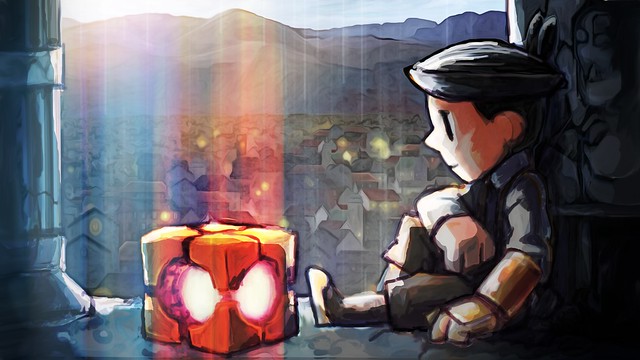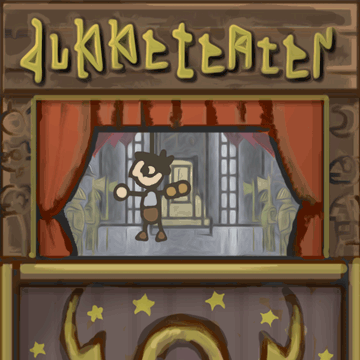
Hi there! It’s Teslagrad Minister of Propaganda, reporting again. We’re going all out here, working on both the PS3 and PS Vita versions of the game, and making progress. And although it’s too soon to talk about a release date (Soon enough!), it’s a perfect occasion to discuss Teslagrad’s art and influences — questions we’ve been asked repeatedly both in interviews and on our social networks.
Of course, having three different artists on the team for a “small” game ensures that there are different influences along the way. And no less important, the game’s art is a core element of Teslagrad, as we rely on visuals to build a silent story.
Character animation is one of the features that jumps out at you when playing Teslagrad. In that regard, and as our artist Ole notes, we shied away from a clean, modern look for the animations for several reasons.
We knew we wanted to do the game in HD, with hand-animated characters, which is a huge task for a tiny team such as ours. We opted to do most character animations in 12 FPS (frames per second), as this would allow us to have a larger move set for the characters without eating up all of the texture space (Hi-res characters eat memory pretty quickly!).
But it’s not just that: in the early days of animation, it was very common to do animations at 12 FPS. So choosing a visual style inspired by that period made it easier to work around this limitation, and in addition to this, we also studied a lot of 16-bit era sprite animations — as those had to do a lot with relatively few frames.
There’s definitely a Disney influence on Teslagrad visuals, although this often relates more to Disney concept art than the actual finished films. The early Disney studios had some madly talented artists working for them, like Mary Blair and Eyvind Earle for instance, and the most interesting stuff is often the early concepts that still carry the individual artist’s fingerprints.
We’re huge fans of The Jungle Book and The Aristocats Disney era, where they photocopied the pencil animation sketches directly onto cels as a time-saving device instead of retracing it and doing cleanup. Nevertheless, Teslagrad owes a bit more to Winsor McCay and Franco-Belgian cartoons like Tintin and Spirou rather than Disney, with a combination of complex backgrounds and simple, readable characters with good color blocking.
Osamu Tezuka is another pretty important influence; Tezuka really was a master of creating iconic designs using efficient and minimalistic shapes. Early print media cartoons can be a good lesson in color blocking characters, as creators were often faced with similar restrictions to those of game designers in the 8-bit era regarding color variety, and had to make sure that characters read well regardless.
Moving on to another subject, we wanted the players to get a lot of enjoyment from the game by simply exploring the world. In Teslagrad, and as our concept artist Petter remarks, we tried to make the game world a place that feels alive and has a history. However, without varying the areas a much as we did, we wouldn’t have achieved the same sense of progression and scale.
With a background mainly in concept art and illustration, being forced to work in a side-scrolling perspective was interesting. While it was liberating not to worry about perspective in the same way, it put a higher emphasis on good shapes and interesting designs. And there was also a surprising amount of effort put into the simple “boring” stuff, like the walls and the floor. It may not be what you remember the best about the game, but it’s important for the core aesthetic of Teslagrad.
Another visual element that caught the eye of many gamers was the mechanical puppet theater. Aslak, our lead animator, is a good example on how Teslagrad influences goes far beyond video games. His experience working as a puppeteer actually informs all of Teslagrad’s animation work.
He worked on a puppet show with a Romanian director once, and he says she always kept repeating that you need to feel what the puppet is supposed to feel while you are performing. Making the puppet move well is important, but without the emotion the performance will never be convincing.
A lot of computer animation seems soulless because people let the computer do too much of the work, and it obviously can’t feel anything. Instead, we tried to put a lot of soul in Faradeus, the mechanical bird. The vision for this monster was to have a fight high up in the air in a thunderstorm for dramatic effect, but as the design of the character and the gameplay progressed, it also became a bit of a comical character, and we tried to make him move like a mix between a T-rex and a chicken, menacing in one moment and clumsy in the next.
That flexibility is why we chose hand-drawn animation. And even when we do computer assisted animation, we try to approach it in such a way that we don’t leave a lot of frames for the computer to handle on it’s own. It takes longer of course, but like a famous animator once said: if you don’t want to do lots of work, what are you doing in animation?














Comments are closed.
16 Comments
Loading More Comments